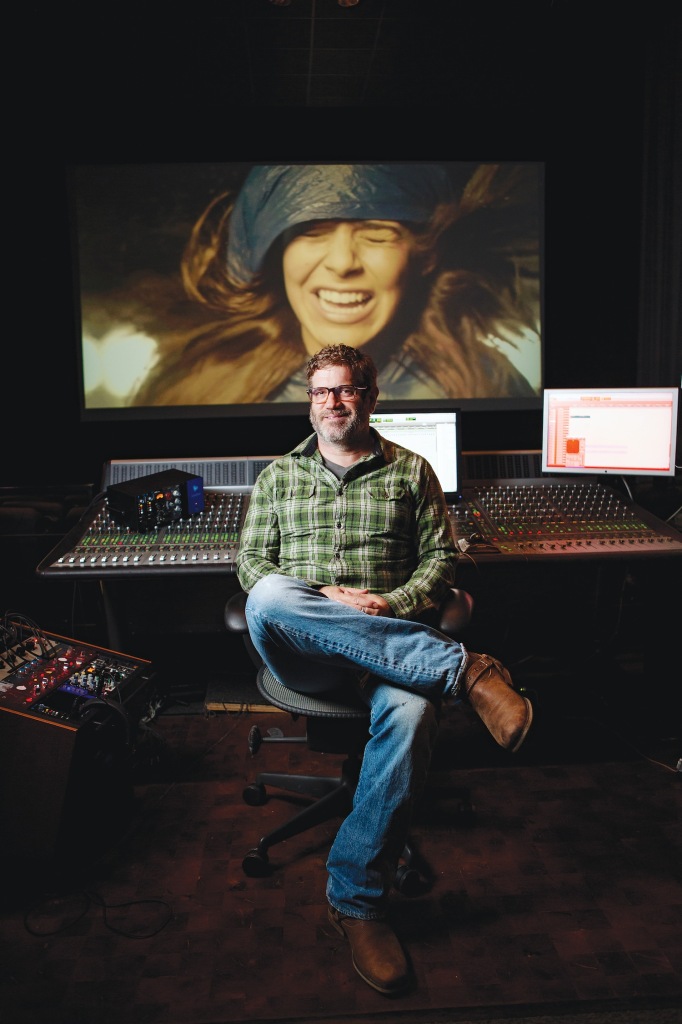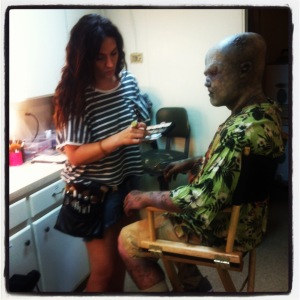The reel life
Movie industry movers and shakers find professional and personal fulfillment in Baton Rouge
You might find Liza Kelso at a local concert, bipping and bopping with verve to a lively set. You’d never know the Natchez native is a former production assistant and accountant on dozens of film projects who now attracts and assists productions as executive director of the Baton Rouge Film Commission.
At press time, Liza was talking to Lord of the Rings star Elijah Wood about bringing his next feature to the Capital City.
“I’m very optimistic, and I like to surround myself with people who are too,” Liza says. “There’s a lot of that spirit here, which is crucial. This is a job where you have to believe in your city.”
Liza earned her chops in the Carolinas in the early 1990s. She was Tom Berenger’s assistant on Chasers. She drove Brandon Lee around every day during the filming of The Crow. And it was on the Charleston set of Ace Ventura 2: When Nature Calls that she met her husband, a veteran grip. Gary Kelso turned down his next offer, a Spielberg film, to spend more time with Liza, and they’ve been together ever since.
After stretches in Los Angeles and Florida, the couple settled in Baton Rouge, with Gary maintaining steady work throughout the state and the Southeast, and Liza as the face and the arms of the local film industry. But this change in location has never meant that she feels out of the Hollywood loop. “There is no disconnect between L.A. and La. anymore,” she says.
The Kelso’s move to Baton Rouge was deliberate. Liza wanted to settle down somewhere that spoke to both her business-savvy talents and her deep Southern roots, roots that hold strong to family and fellowship and nature.
“Ultimately, we did have a choice as to where to live,” she says. “We wanted a place where our boys could spread out and move.”
There are myriad things to schedule during a film shoot, but generally “play date” does not make the daily call sheet. And yet the children of cast and crew had regular hang sessions during Baton Rouge’s early spring production of Zipper, the political and relationship drama co-produced by Kelso’s predecessor at the film commission, Amy Mitchell-Smith.

“This is a very community-minded place, and having so much help from in-laws with our two daughters and a strong support system of friends and family is irreplaceable,” Amy says.
A veteran of Miramax in New York City, she relocated to Louisiana after Hurricane Katrina as part of a disaster-relief effort. Here, she met her husband and stayed, helping build the film commission into what it is today. Since joining the private sector in 2012 with the launch of Cienega Motion Picture Group, Amy has co-produced a variety of feature films, with a half-dozen more in the pipeline, and aimed at festivals like Sundance, Tribeca and Berlin.
Flying in over the vast green canopy of trees while bringing prospects to Baton Rouge used to be an odd sight for this former New Yorker; now it is simply comforting. Amy wouldn’t be the filmmaker and the mother she is if she weren’t doing both in Baton Rouge.
A self-described risk taker who enjoys provoking positive change, Amy loves working in a city that hasn’t hit or even seen its ceiling yet.
“Of course New Orleans has a global brand, but what’s great about Baton Rouge is just how easy it is to work here,” she says. “We are still an emerging market, and there is so much energy in that.”

Photo by Collin Richie
Jerry Gilbert, Celtic Media Centre’s resident sound-mixing specialist through his company PostDigital, is also banking heavily on Baton Rouge’s status as an emerging market.
Eight years after migrating from California, the Santa Rosa native is in the process of expanding his firm’s offerings to include a stem-to-stern suite of post-production services—basically handing producers every audio visual nip, tuck and addition that a film needs to be ready for the big screen.
Jerry has mixed sound for more than 120 projects, including Oscar winners like Dallas Buyers Club, crowd-pleasers like Saw, and even the early films of Rian Johnson, who was tapped this summer to direct Episode VIII of the Star Wars series.
As he talks—and Jerry can talk movies for hours on end—Liza leads a delegation of HBO executives into the room. One in particular peppers Jerry with questions, and by the end of the sound-mixer’s humor-laced description of what he and his company do, the visitors are rapt for more.
“Of course the tax credits are great and the cost of living is more beneficial here than in L.A., but in general L.A. is so much more stressful,” Jerry says. “I wasn’t getting home from work before midnight. I was eating terrible takeout food every day.”
He says his arrival in Baton Rouge was his opportunity to become healthy—both with his body and his business.
When he’s not holed up in the darkened screening room inside Celtic, pouring over every aural detail of Hollywood’s latest picture, Jerry is probably doing CrossFit training—“Some days aren’t so bad, but it can definitely be brutal,” he admits—or relaxing on the patio of the Bulldog with a beer and some friends.
On weekends, he hits the skate park at BREC’s Perkins Road Park, where he is often joined not only by his son but also many of the neighborhood children, too. It’s a little taste of southern California in the heart of Baton Rouge, and that’s how he likes it.
“The whole big fish in a little pond thing is definitely something to consider,” he says.
While Jerry left L.A. for the frontier of filmmaking in Louisiana, Daniel Lewis says he learned of the kind of experience people like Jerry had in California and New York, and that’s why he never left his home state. Being a lower-level executive at a major studio never appealed to the Active Entertainment co-founder.
“Either you’re being controlled or you’re in control,” Daniel says. “And I was never one to fit the mold.”
There was a time when being a film producer in Louisiana wasn’t exactly a “thing”—at least it wasn’t something many from here grew up thinking about doing. Daniel entered the film business through finance. He worked at a large bank and was the guy who understood Louisiana’s tax incentives program better than anyone. He parlayed that knowledge into a producing career and launched Active in Lafayette with business partner Ken Badish in 2008. They have shot almost all of their productions in the state and relocated their headquarters to Baton Rouge, where Daniel grew up, a few years ago.
“There’s a great corridor of creative filmmaking in south Louisiana between Lafayette and New Orleans,” Daniel says. “And Baton Rouge is right in the center of it.”
For the 32-year-old LSU alum, there is nothing like being home. It’s easy to strike a balance between work and life here, he says. With his eye on the future, Daniel hopes the next generation here will grow the industry even more.
“It’s about giving people opportunities to work right where they grew up,” he says. “I meet so many parents who talk about how their kids moved far away to work, and now I have a daughter, and I know that if I can be a part of keeping someone’s children close to home, then that right there is worth every ounce of sweat and hard work that goes into this.”

One young local artist who has been able to remain local while also advancing her craft and career, thanks to the Hollywood invasion into Baton Rouge, is Grace Emden.
Four years ago, Grace was making themed and designer cakes for weddings and birthday parties, the creative kind like those seen on Ace of Cakes and the Food Network. When The Twilight Saga: Breaking Dawn needed something gorgeously delicious-looking on the table for its vampire clan’s dinner scene, Grace got the call.
But it wasn’t the film’s stars, Robert Pattinson and Kristen Stewart, who caught her eye on set. It was the makeup department, a team she saw using the same skills she employed in cake decorating, only with a very different medium. She knew right then she wanted her career to switch gears. A string of projects, including actor and director John Schneider’s Smothered, has followed.
“Movie work kind of fell into my lap,” Grace says. “Since Twilight, projects have been steady, and I’m always surrounded by inspirational people. We have a lot of talent here, so I hope the industry continues to grow.”
Grace’s film career has blossomed from more routine makeup jobs to working closely with writers and directors on character concepts and designs using complex prosthetics and advanced makeup techniques. Now, when a character goes from script to screen, Grace is right there with the filmmakers and actors for the ride.
“Designing high-end creative cakes was a great outlet, but I had hit a plateau in Baton Rouge,” Grace says. “I still bake some, but it’s just at home for fun. The truth is, there’s nothing like having a character come to life in the makeup chair.”
The film industry may be firing the imaginations of more Baton Rouge-born creatives than ever before, but the growth of the local industry is not simply keeping young talent from fleeing the city. It’s luring back those who left years ago.

“I was burnt out on the L.A. attitude,” says Elizabeth Hutchison, a 40-year-old Baton Rouge native who spent more than a decade in Hollywood working behind the scenes of some of TV’s biggest shows, including Survivor and The Amazing Race. She returned home in 2009 to continue her media career and now oversees the Baton Rouge operations for a long-running crew-training program called the New Orleans Video Access Center. Elizabeth coordinates a variety of workshops, seminars and training sessions for locals who want to be script supervisors, grips, gaffers, lighting specialists and more.
This fall Elizabeth’s training hub will move into the new Creative Bloc building downtown. When she’s not exercising at LSU lakes, she loves experiencing the restaurants and performance venues in a city center that is far livelier than when she left it in 1998.
“Here I feel rejuvenated,” Elizabeth says. “There’s an enthusiasm and a spirit of community in this city that I haven’t felt anywhere else.”
Next year, Elizabeth will help NOVAC launch a new film apprenticeship program to recruit for and facilitate the making of four short independent films—all featuring local talent. Since March, her events in Baton Rouge have readied more than 90 people for their first jobs on movie sets.
And making sure these newly trained crew members have more employment opportunities in film and television right here in the Red Stick will be Kelso.

The commissioner. The connector. The believer.
The woman who left her work on Hollywood sets far behind and now goes to work every day to bring as many of them as she can to the adopted home she loves.
“Baton Rouge is a place where the process of becoming is always present,” Liza says. “This city is continually on the cusp of defining and improving itself, and that’s an evolution that never stops. The proof of that is in the people. We all want to make Baton Rouge better.”












